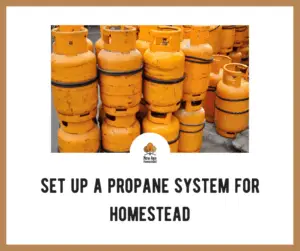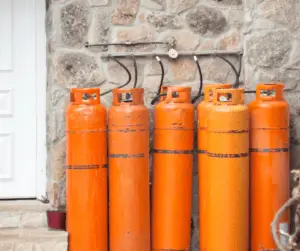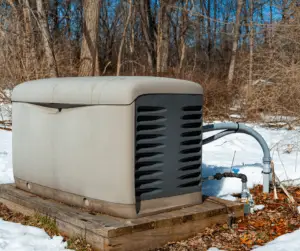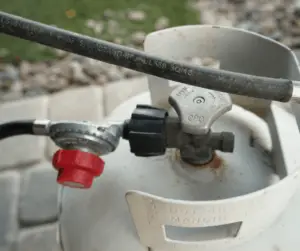If you’ve been looking for a way to set up a propane system on your homestead, then you’ve lucked out; here’s a complete guide.
Propane is a very underrated fuel, yet it still proves very useful for so many circumstances.
It can be used for several critical daily activities, such as heating, cooking food, and power.
The fuel itself is inexpensive, all things considered, making it an all-around excellent fuel to have on a homestead. It essentially fuels all necessities, allowing you to live off-grid.
You’ll no longer need to worry about firewood, electricity, or the ability to cook, to name a few. Despite this, setting up a propane system can be overwhelming to novices.
This is why I’ve created a complete guide on how to do this the correct way. If you approach this in the wrong manner, it could lead to disaster or a loss of valuable propane.
Luckily, if you take advice from a propane professional, installing a propane system can quickly be done. However, I do not condone doing this yourself, unless it’s a portable tank.
Choosing The Right System for your Homestead
The Type & Size
Single-Use
If you’re going to be using propane only on rare occasions, such as camping trips, then a single-use cylinder will suit you best.
Single-use cylinders are usually much thinner; therefore, they are less durable than regular, full-sized tanks. This means that you should be very cautious with handling them.
However, they are otherwise excellent for more short-term use. Most of them, as the name suggests, cannot be refilled.
If you find a way to refill it, I do not recommend doing so, as it may result in leaks. They’re also great to store for short-term snowstorms, in case other means fail or firewood is hard to get to.
I’d suggest having a few of these on hand, though, as you may run out of propane in the primary tank. Plus, single-use tanks are great to use for hunting or when working outside in a workshop.
Refillable
Refillable propane tanks are the most common type of tank, most commonly in the size of 10 pounds, more or less.
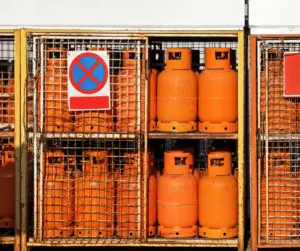
These are best used for less demanding uses, such as grilling, temporary heating, cooking, or fueling a propane-powered generator.
Refillable tanks, unlike single-use tanks, are made to withstand much more roughness, although you should still handle them with care.
If you opt for a smaller, one-gallon tank, it can still unquestionably be used as a portable tank.
However, these tanks can get as large as 500 gallons, although there are regulations on this that must be followed in some areas.
Stationary
These are also refillable but are commonly mounted to the ground and left there permanently. Stationary propane tanks are best used for supplying propane to entire homes.
The uses could be to fuel propane heaters to keep the indoors warm, cook and use propane stoves, and power larger propane-powered generators.
Stationary tanks are typically much more extensive, with 250-500 gallons being a standard size. This means that it can be filled and have enough supply to last a long time.
Due to their much larger size, it can be pricey to fill them, often upwards of $500-$2500 or more. However, a full 250-gallon tank is going to last a while.
One vital aspect to remember is to make sure the propane tank is blocked from being dinged by a lawnmower. If a rock hits the tank and causes a spark, then you know the result.
What Propane Can Be Used For
Cooking
Propane is one of the most sought-after ways to use as a fuel for cooking. It’s preferred by over 90% of all professional chefs, and for a good reason.
Propane is excellent to use as a fuel for cooking in itself, whether it’s saving you in electricity costs or having to start a fire, which isn’t always convenient.
Cooking with propane doesn’t use much of the fuel, either, as it doesn’t take much of a fire to heat a skillet or get an oven to temperature.
Propane is excellent at providing even heat spread too, and it allows for instant temperature control.
Plus, it can be used to fuel propane grills, which cook very well. The only real negative is the lack of charcoal flavor, but that is a personal preference.
Heating
This should go without saying for most, but propane is incredible to use as a heating source.
It may be surprising to hear, but heating your home with propane costs much less than using electricity, or even sometimes if you only use solar power, as it’ll save you energy.
Nonetheless, propane is proven to be useful to use as a heating option. I’ve used propane heating several times, and if one thing is for sure, it will heat your home very quickly.
The best part, though, is the simplicity. If you have a propane heating system, it won’t be necessary to cut firewood unless you’d prefer.
It can also fuel propane-fueled water heaters, which are a great electric water heater replacement.
They heat up very fast and save you from having to power a traditional electric water heater with your solar battery banks.
Power
Finally, propane can be used as a fuel to power your home. This can be done by using it to power propane field generators, which are very fuel-efficient.
Propane generators are surprisingly powerful, so they can easily supply a 2000 square foot home with an adequate amount of electricity, depending on the size.
A huge plus with propane generators is that they are incredibly durable. This is due to the propane’s lack of degrading additives that gasoline and diesel typically have.
I’d recommend buying a small and large propane generator; this way, you can have access to power both at home and when you’re out in the field working on projects.
Propane System Installation
Installing The Tank
Let’s assume you’re going to be using stationary propane tanks mainly.
The tank should be placed away from home; I typically recommend up to 50 feet, but please refer to your local regulations.
You should put it on a concrete pad, which will prevent the heavy tank from sinking while also providing stability.
I’d also suggest bolting the tank down if it has proper brackets on the stands. If you ever face a storm such as a hurricane, it could flip the tank over, especially if it’s lightweight.
It certainly should always go without saying, but never put the tank in a closed space, such as a shed or building. It should also be easily accessible so that it can be refilled when it’s low on propane.
Running The Lines
The first step to having propane in your home is by running a copper line to your home.
A rubber line that is specifically designed for liquid propane can also be used, but this is not at all recommended.
A very vital thing to remember is never to go the cheap route.
The lines should be buried at least two feet below ground, and the area should be visibly marked to avoid any accidents from digging.
I’ve placed flags which were about 12’’ tall over the lines. Always make sure the actual flag doesn’t rot and fall off, making the flag unnoticeable.
Hooking Up Appliances
Next, you’ll need a regulator, which goes on the end of the propane line before it hooks into the appliance.
A regulator works by lowering the pressure coming from the line, as the pressure is often way too high to connect into an appliance and use. Trust me, do not skip this step, or it won’t end well.
Some appliances may require a specific connector, but these are sometimes provided when the appliance is purchased.
There are many different regulators out there, so I’d suggest one that is adjustable and can be used for various BTU applications.
You’ll also need to make sure all connections have vinyl tape surrounding the male ends, as it will help seal together the male and female; do not avoid this, as it could result in leakage.
A Few Tips
Carbon Monoxide Detector
The most essential thing to do, even before you have propane in your home is to install carbon monoxide protectors in every room.
Propane systems have made incredible strides to improve the safety of their tanks and appliances, but they’re never guaranteed not to fail.
The chances of failure are low, just like with house fires. However, it could save your life, or at a minimum, alert you of any unknown leaks that you’re unaware of.
Have It Regularly Checked
It’s easy to have the propane tank installed, the new appliances hooked up, and forget about it for years. Yet, this could prove devastating to yourself, or at the very least, the propane tank.
Propane tanks are generally reliable and can withstand years of usage, but they’re not immune to damage.
There could be a small propane leak, which would be picked up if checked by a professional. This could use a significant amount of propane and happens more than people think.
Never Relight The Pilot Light Yourself
While it’s possible and can certainly be done by yourself, I do not at all condone doing so. If you don’t know precisely what you’re doing here, it could lead to devastating consequences.
Never try this unless you have been appropriately trained; all it takes is one time to result in an accident. I’ve known of a few people landing in the ICU due to not knowing what they’re doing.
Most propane companies can come the same day to relight a pilot, so it’s usually a quick process, requiring a quick phone call.
Frequently Asked Questions
How Much Do Propane Systems Cost?
The equipment cost will vary drastically due to the different sizes and types available, but you can expect to invest around $5,000 for the initial install.
The usage cost is also going to vary, but it will typically cost, on average, $3500 per year at a minimum to keep a home warm and use the propane for cooking.
This can be lower if you opt for appliances that are propane efficient. While they may cost a bit more, it will save you time and money in the long-run.
Can I Install My Propane Tank?
Yes, but you should not attempt doing so, ever. Installing a propane tank, particularly the stationary kind, is extremely dangerous.
You could use an incorrect connector, regulator, or pipe, which would result in extremely undesirable consequences.
An installation is a one-time process. I highly suggest leaving this up to the professionals, as they do this work every day. You wouldn’t let a backhoe operator pilot an airplane.
Which Material is Best For Propane Lines?
If you want your propane system to stay safe and avoid unnecessary mishaps, using the correct lines is vital.
I’d recommend that you go straight to the best option and opt for copper flex lines. This type of line will last forever, and they’re safe to bury underground without the worry of erosion.
You can choose other materials, but they’re not going to provide the amount of safety and reliability that a copper line will offer.
Verdict
Homesteading is a straightforward, yet challenging way of life. Everything you need can be sourced from nature, but sometimes we could use a little more help.
Propane is an excellent choice for those of you needing a break from woodcutting for a while, or perhaps you’d rather spend a little extra on propane to avoid using your power banks all the time.
The fuel may be used for cooking, heating, and fueling propane generators, so you’d be hard-pressed to find any better fuel.
The only negative is the cost, but I think that the luxury it provides is entirely worth it. It’s great as a back-up yet also excellent as a primary fuel source.
If you’re going to use propane as a primary fuel source, invest in quality appliances if possible, as they’re much more efficient than cheaper ones.
